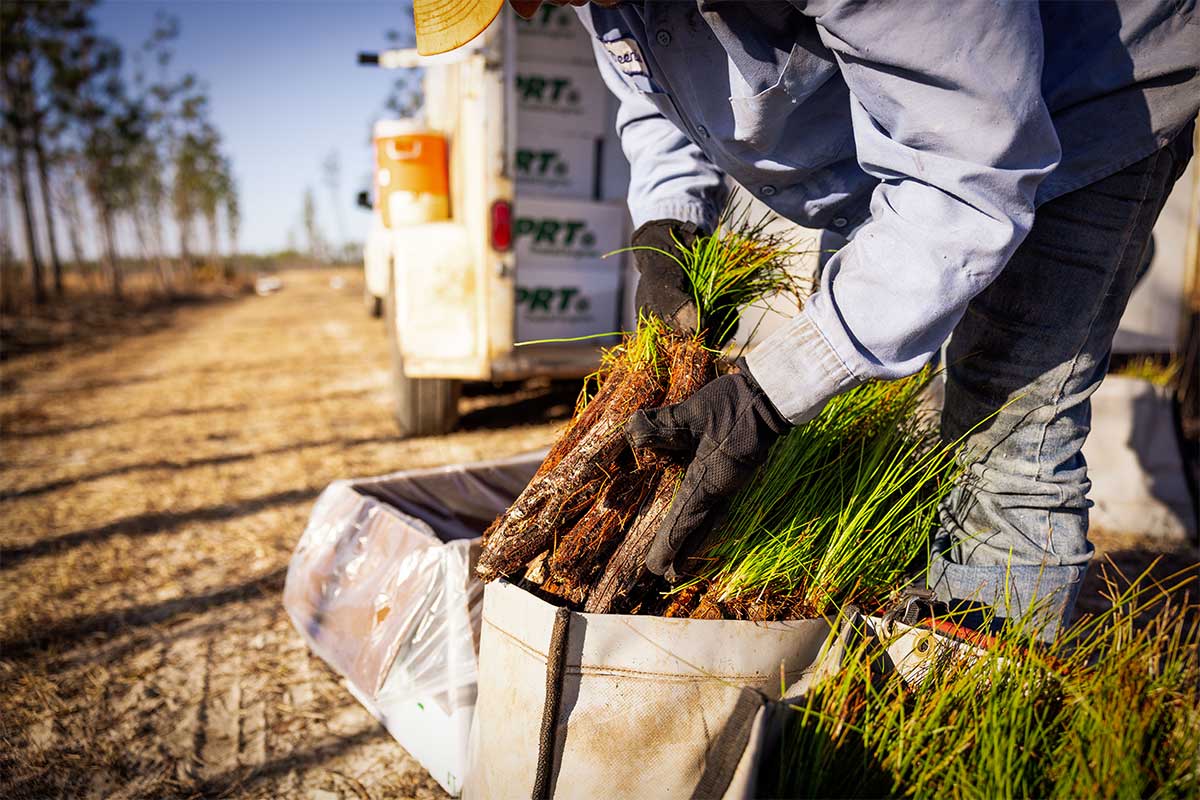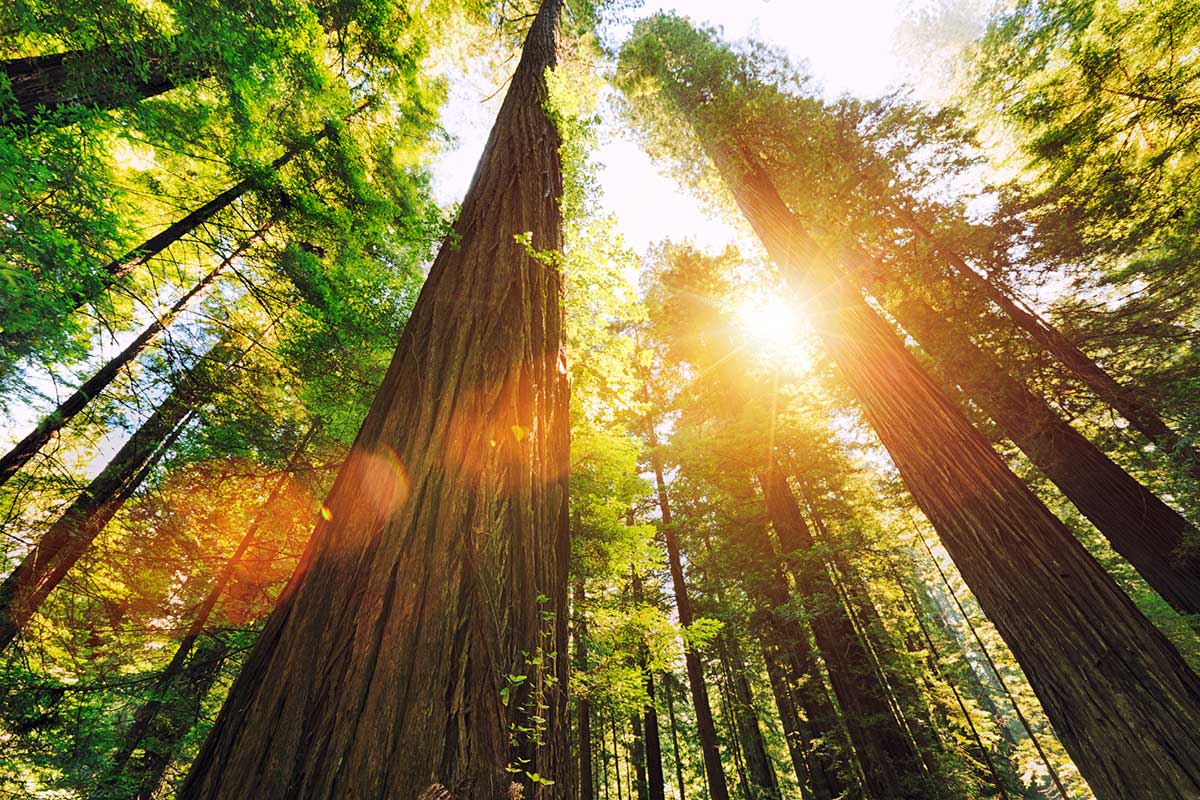A Tree Can Be A Solution
Capturing carbon emissions, supporting marginalized communities, protecting biodiversity, mitigating the effects of climate change — we can’t live without trees. Through tailored initiatives, we help you address some of the biggest issues your organization cares about while meeting your ESG, CSR, and sustainability goals. Together, we can plant and protect trees in the forests and neighborhoods that need them most.
Impact On a Global Scale
With an unmatched and far-reaching network of partners, we’re meeting needs at every level and on every continent.
Partnership in Action

Target Employees Dig In
Target team members in eight cities across the U.S. showed up in force to improve the communities they call home — planting more than 2,000 trees.
Church & Dwight Offsets Carbon Through Trees
When one of America’s oldest companies set the goal to be carbon-neutral by 2025, they turned to the Arbor Day Foundation to have a global impact.
Williams-Sonoma, Inc.
As a company with many popular home-furnishing brands, Williams-Sonoma, Inc. (WSI) is committed to using responsibly sourced wood in their furniture.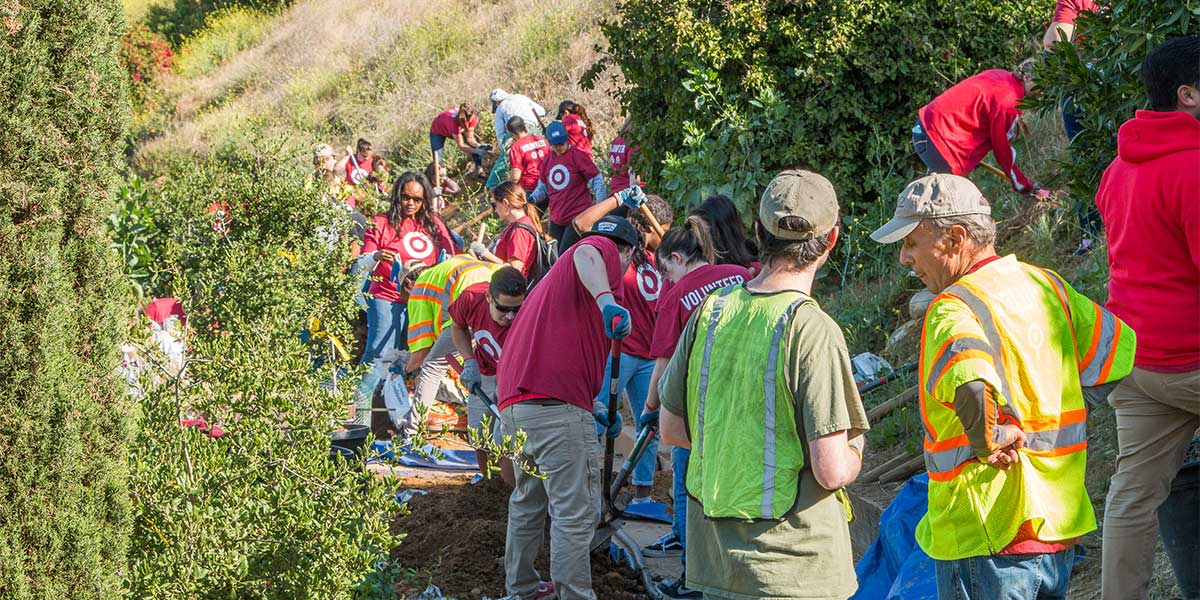
Target’s Ask
Target employees expressed a desire to enhance the communities in which they live and work.
Target saw this as an opportunity to amplify their Environmental, Social and Governance goals, specifically in the value they bring to their communities. They were looking for a partner who could scale thoughtful, high-impact local projects across the entire nation.
Arbor Day Foundation’s Answer
Not every community has the same need — which is why the Arbor Day Foundation worked with Target to identify key necessities in the areas they wanted to plant.
Stretching across America from Philadelphia to Santa Barbara, our local network helped plant trees that served a variety of needs — including low-income neighborhoods with low-canopy coverage, food desert communities that needed sustenance, and cities damaged by wildfires and natural disasters.
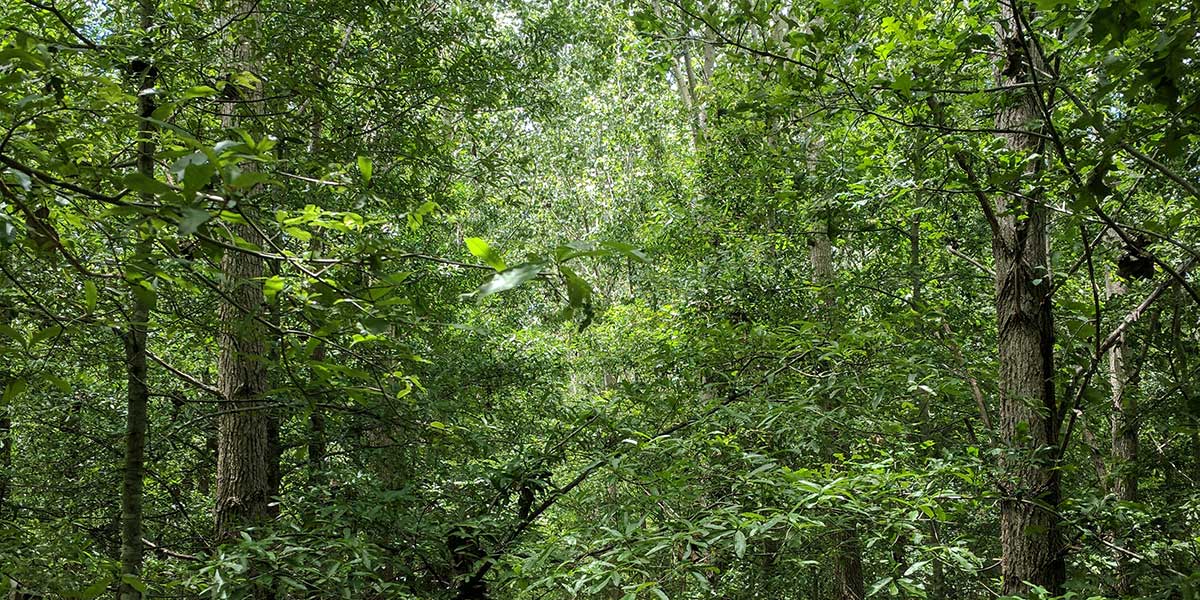
Church & Dwight’s Ask
With heritage in conservation efforts, Church & Dwight launched their mission in 2017 to achieve carbon neutrality by 2025.
However, after two years of energy reduction initiatives, they were searching for opportunities to reach carbon neutrality in a more economically viable way.
Their next frontier was focused on offsetting, primarily through forestry carbon credits and renewable energy credits (RECs) — and they needed a partner to help them navigate the path forward.
Arbor Day Foundation’s Answer
To ensure Church & Dwight would meet its target, the Arbor Day Foundation examined the source of their carbon offset challenges — finding fossil fuels and corporate travel as the primary culprits. And since RECs fail to offset fossil fuels, the Arbor Day Foundation created a program that filled the gap.
The Arbor Day Foundation used Church & Dwight’s offsetting program to not only reinforce their long-time support of wildlife conservation — but also target an area of high need: restoring degraded crop lands in the Mississippi Alluvial Valley.
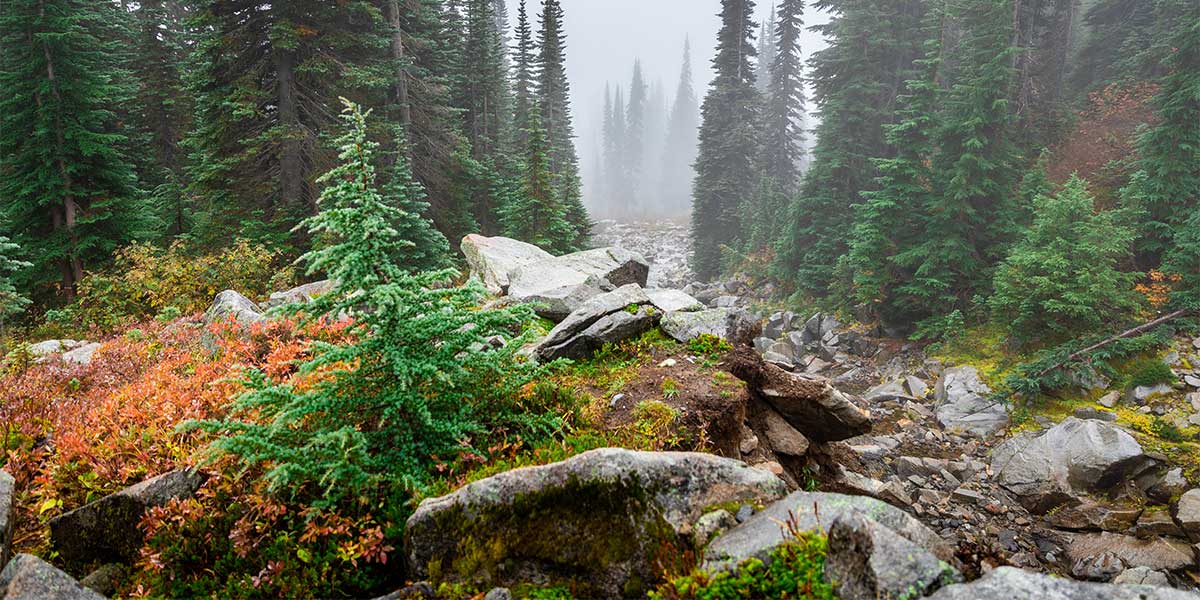
Williams-Sonoma, Inc.’s Ask
As the world’s largest digital-first, design-led and sustainable home retailer, Williams-Sonoma, Inc. (WSI) is committed to using responsibly sourced wood in their furniture.
In January 2021 Pottery Barn, a premier specialty retailer under Williams-Sonoma, Inc. partnered with the Arbor Day Foundation to plant 3 million trees by 2023. The success and impact of Pottery Barn’s planting efforts prompted several other brands in the WSI family (Pottery Barn Kids, Pottery Barn Teen, West Elm, Rejuvenation, and Williams Sonoma Home) to join the cause. Working as a team, these brands committed to doubling their planting efforts, resulting in an expanded goal of 6 million trees planted by 2023.
Arbor Day Foundation’s Answer
In its first year alone, Pottery Barn’s campaign planted 1.5 million trees in forests with the most need, spanning from Indonesia to Oregon.
With the groundwork already in place for the initial campaign, the Arbor Day Foundation was able to quickly scale its efforts to accommodate the profound new goal and get WSI’s home-furnishing brands — six in all — up to speed. The increased participation along with the Arbor Day Foundation’s experience and world-wide network of planting partners, ensured that we could help WSI grow its efforts twofold.
Integrated process from idea to achievement.
1
Vision
We’ll help you articulate your goals and align them with projects that are designed to help you reach your desired results within budget.
2
Execution
Through 50 years of experience, intimate knowledge of the nature-based solutions space, and a global network of planting partners, we cover every detail of your project from start to finish.
3
Communications Support
You’ll have exclusive access to our skilled communications team who will help you craft internal and external messaging that details a story
worth telling.
4
Comprehensive Reporting
Whether it’s through our proprietary Impact Dashboard or in-depth recap reports, we provide the complete picture of your company’s environmental accomplishments.
Communications Support
We’ll help you craft your sustainability story. Our skilled team of communications experts provide you with guidance, best practices, and, depending on your project level, creative executions to connect with and engage your internal and external stakeholders.
Comprehensive Reporting
Whether it’s through our proprietary Impact Dashboard or via in-depth recaps, we help you align your reporting goals with CDP, SBTi, Project Gigaton, and other protocols and standards.
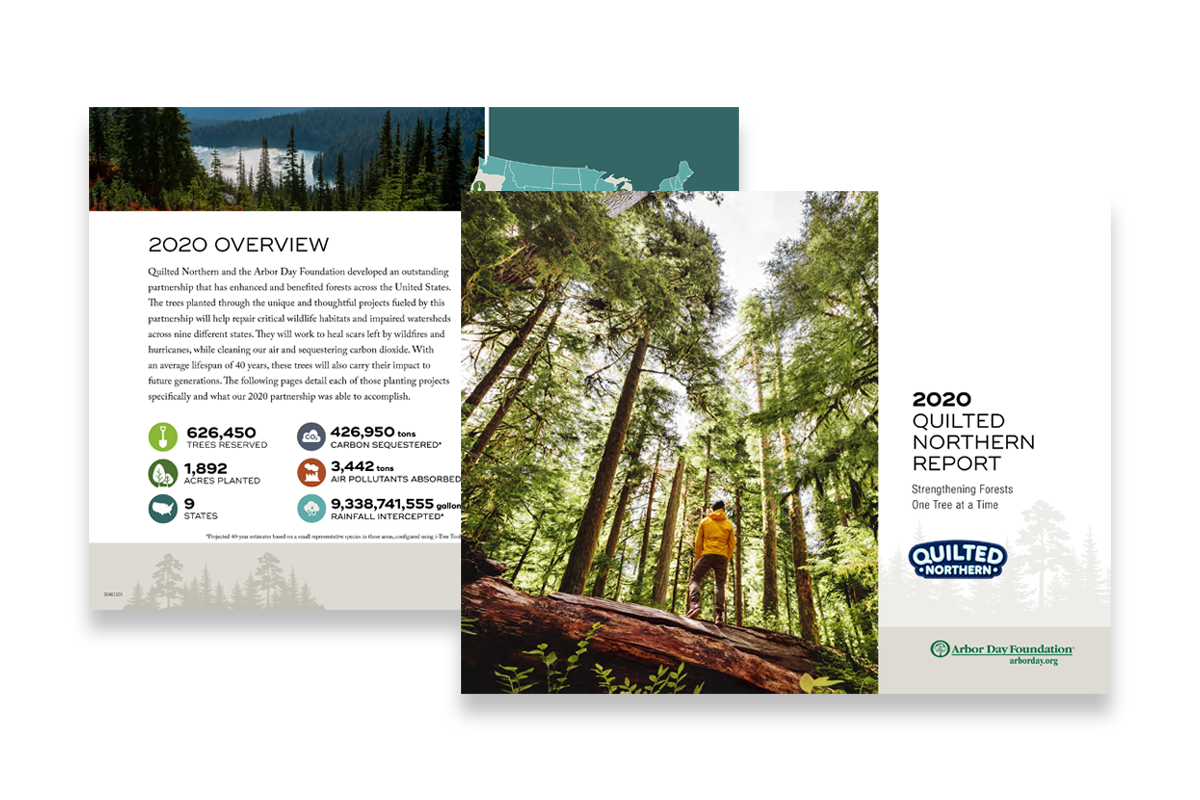

Our Commitment to Global Goals
Work happening through the Arbor Day Foundation makes a positive impact on 9 of the 17 Global Goals.
1 No Poverty
Trees are a clear path to eradicating cycles of poverty. Our global reforestation efforts have contributed to economic opportunities, food security, disaster recovery, and sustainable farming practices.
2 Zero Hunger
Trees have made a significant difference in the global fight against hunger. By planting more trees, we can improve the quality of the soil, reduce the risk of flooding, lessen soil erosion, shade agricultural fields, and, of course, directly grow food.
3 Good Health and Well-Being
From large forest ecosystems down to neighborhood canopy cover, research shows that trees contribute to better health and well-being metrics. We leverage GSI, air quality, and other strategic data points to determine where trees can do the most good for human health.
6 Clean Water and Sanitation
Trees play a key role in maintaining our global water cycle by mitigating flooding and reducing storm runoff. 75% of the world’s accessible freshwater and about one-third of the world’s largest cities depend on forested watersheds and wetlands for their drinking water.
8 Decent Work and Economic Growth
The world’s forests may make up only 31% of land mass, but they support the livelihood and prosperity of millions of people. That’s why we believe in the importance of managing forests, so they continue to provide a broad range of economic goods and services over the long term.
11 Sustainable Cities and Communities
Urban sprawl is one of the biggest threats to our climate, natural biodiversity, wildlife habitats, and our physical and emotional well-being. Trees and other green infrastructure provide a sense of calm and balance by cleaning the air, improving our health, and creating more sustainable cities.
13 Climate Action
As CO2 levels continue to increase, so will human costs related to ozone pollution, heat waves, hurricanes, infectious disease outbreaks, river flooding, and wildfires. Forests are the most advanced carbon sinks on earth, sequestering about 10–15% of U.S. CO2 emissions.
15 Life on Land
Forests are home to 80% of the world’s biodiversity. The Amazon region alone makes up 40% of the earth’s tropical rain forest and is home to half of the known animal and plant species. Planting trees is a great way to regenerate and expand the world’s forest resources while protecting the planet’s ecosystem.
17 Partnerships for the Goals
We’ve built a global network of disparate organizations, leaders, and partners, harnessing their collective power to drive meaningful impact through trees. Our collaborative and inclusive approach ensures that we’re always finding innovative ways to fulfill our mission: inspire people to plant, nurture, and celebrate trees.
A Tree Can Be Momentum
There’s no goal too small. No intention too ambitious. No idea too lofty. Because every action we take today will lead us to a better tomorrow.
Meet Our Team

- Dan Morrow
- Vice President, Programs and Partnerships
- 402-473-2119 | [email protected]

- Abbie Eisenhart
- Director, Corporate Partnerships
- 402-473-2038 | [email protected]

- Grace Widseth
- Director, Corporate Partnerships
- 615-300-8051 | [email protected]

- Ben Wilinsky
- Director, Partnerships and Innovation
- 402-473-9574 | [email protected]

- Mairi-Jane Fox, Ph.D.
- Director of Carbon Planning & ESG, Arbor Day Carbon
- [email protected]

- Jeremy Manion
- Managing Director, Carbon Markets, Arbor Day Carbon
- 402-473-9561 | [email protected]

- Jeff Ashelford
- Manager, Corporate Partnerships
- 402-473-2118 | [email protected]

- Bryan O’Donnell
- Manager, Corporate Partnerships
- 402-473-2039 | [email protected]

- Becca Hebbard
- Manager, Corporate Partnerships
- 308-764-7114 | [email protected]

- Graham Pansing Brooks
- Manager, Corporate Partnerships
- 402-430-6432 | [email protected]

- Hillary Prince
- Carbon Lead - Corporate Partnerships
- 402-473-2031 | [email protected]

- Tina Hammer
- Partner Relationship Manager
- 763-486-9067 | [email protected]

- Maggie Malone
- Partner Relationships Manager
- [email protected]

- Keona Koster
- Partner Relationship Manager, Corporate Partnerships
- 402-473-2034 | [email protected]

- Chandler Ashburn
- Partner Relationship Manager, Corporate Partnerships
- 813-362-9410 | [email protected]

- Lauren Stuart
- Implementation Coordinator
- [email protected]
Contact Us
We look forward to discussing how trees can support sustainability efforts throughout your organization.

